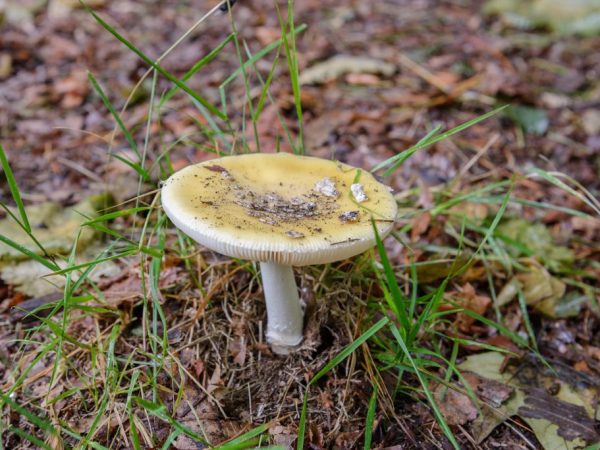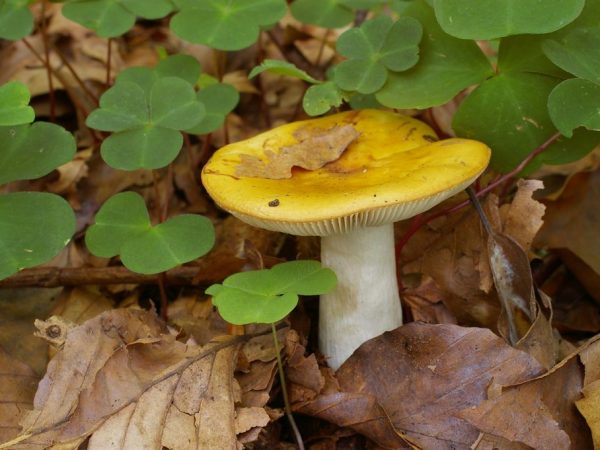Description of the mushroom russula light yellow
Russula inhabit deciduous, coniferous, mixed forests of Europe, Russia, the Far East. The russula light yellow does not have a clear fruiting period, so it is harvested from early spring to the beginning of winter.

Description of the mushroom russula light yellow
Description of the mushroom
The mushroom belongs to the genus russula, russula family. The family got its name because of the ability to eat its representatives raw, without heat treatment. The russula prefers wetlands for growth. The fruiting body has a cap-toothed structure familiar to our eyes.
Hat
The upper part of the fruiting body usually has a diameter of 3 to 12 cm. The age of the fungus affects the shape and appearance of the cap. It happens:
- hemispherical;
- convex;
- flattened, slightly depressed;
- having grooved edges.
The color of the cap is yellow or golden ocher. The central part is yellow-green. From above, the skin on the cap is smooth, easily peeled off.
Light ocher plates, densely spaced, partially attached to the peduncle. If damaged, then they turn gray.
Ocher spores are 8-10 x 7-9 µm in size. They are ovoid, prickly in shape. The mesh is well developed. The absence of pileocystids is characteristic - special sterile elements in hymenium, which protect against damage to the structure in which spores are formed - basidia.
The inside of the cap is elastic, unbreakable flesh. Its color is white-gray. The aroma is sweetish-floral, the taste is slightly spicy. On contact with air, the pulp usually turns gray.
Leg
The leg is in the shape of a cylinder that tapers towards its base. The flesh of the stem is light gray or yellowish, whole, soft but not brittle. Fibers are not visible.
The flesh is slightly stiffer than the cap. When interacting with air, it also begins to turn gray.
Irina Selyutina (Biologist):
The russula is light yellow, or, as it is also called, the russula is yellow, is a mycorrhizal forming agent and enters into symbiosis with birches. Representatives of this species are usually found in damp birch or pine-birch forests. You can also find them on the outskirts of the marshes - in the moss. They settle in small groups. They are most often found in the northern forest regions.
When collecting these mushrooms, it is important to learn how to distinguish them from the pale toadstool, which may have a yellowish variation in the color of the cap. The mushroom picker needs to remember 2 points:
- The russula never has a ring ("skirt") on its leg.
- At the base of the leg, there is no swelling surrounded by a volva - the remains of a common blanket in the form of a pouch.
Edibility
Light yellow russula belongs to category 4 conditionally edible mushrooms. In terms of nutritional value, it is inferior to ocher russula, which is also edible and belongs to category 3.
Representatives of the species received such a characteristic due to the frequent defeat by worms and insects. Also, a slight bitterness in taste is inherent in the species, giving a spice to the taste.
The species looks like a spicy-pungent russula. This poisonous variety differs from the edible "colleague" in the following ways:
- cap color: purplish black;
- leg color: pink;
- pulp color: yellow.
Useful properties and contraindications

Mushrooms should not be eaten for gastrointestinal diseases
Light yellow russula is not as edible as its famous "relatives". The presence of nutrients puts this yellow mushroom on a par with most others. The composition includes:
- mono - and disaccharides;
- carbohydrates - 1.5 g, proteins - 1.7 g, fats - 0.7 g (per 100 g of fresh product);
- lecithin;
- alimentary fiber;
- vitamins: B2 (riboflavin), PP, C;
- trace elements: phosphorus, iron, potassium, magnesium, sodium.
The product has a low calorie content: for fresh fruit bodies, it is 15 kcal / 100 g.
These mushrooms are forbidden to be eaten by such categories of people:
- children under 7 years old;
- pregnant nursing mothers;
- To old people;
- patients with gastritis, pancreatitis, stomach ulcers, duodenal ulcers and other diseases of the digestive system.
Application
Regardless of the purpose of application, the light yellow russula is cleaned of skin and dirt. Only young, dense specimens are selected.
Wormy mushrooms are thrown out entirely - without cutting out the damaged parts, since the eggs of parasites may be inside.
Manipulations are carried out in the first hours after collection. This reduces the risk of spreading the infection to healthy mushrooms. The product is then washed. In this case, it is better to have a colander. Fruit bodies are soaked in cold water with salt or boiled with the addition of peeled onions.
In cooking
The light yellow russula can be eaten in various forms. Mushrooms are served raw with salt as a separate dish.
For your information. You can serve russula raw with salt on the table only if you are sure of their environmental friendliness, i.e. they should only be collected in an ecologically safe area. Shredded fruit bodies are added to vegetable salads, baked with cheese and potatoes.
Pizza and pies are often made from mushrooms. Fruit bodies of light yellow russula can be salted, pickled, dried.
Mushrooms must be stored in a refrigerator. It is imperative to use a separate compartment to keep out other foods. For freezing, use sterile clean containers. The shelf life is up to 8 months.
In medicine
Light yellow russula has bactericidal properties, which helps a person to quickly cope with skin diseases. The yellow mushroom is part of a number of ointments and lotions.
The forest product promotes the elimination of cholesterol due to its high lecithin content. For maximum effect, the mushroom is eaten fresh.
In the Far East, light yellow russula crushed into powder are part of anti-aging, smoothing cosmetics for the face. It accelerates the regeneration of the skin, makes it fresh and improves its color.
Growing
The russula can also be cultivated independently. This helps to get less damaged mushrooms than those brought from the forest. You can either bring mycelium from the forest or purchase grain mycelium from a specialty store.
Planting mycelium in open ground is recommended all year round, except for winter. A shaded place is chosen in the garden. Its area should be approximately 2-3 m2... Then, a depression of 25-30 cm is dug over this entire area. The nutrient mixture is poured:
- 1 layer (bottom): 10-12 cm consists of dried foliage, wood, grass;
- 2nd layer: 10-12 cm are filled with forest humus, earth from under a birch;
- 3rd layer: 3-4 cm thick, a mixture of dry mycelium and soil is laid out;
- 4th layer: duplicates 1;
- 5 layer (surface): 2-3 cm thick, consists of garden soil.
After planting, drip irrigation is carried out. The fruiting period is extended, so the first mushrooms begin to be harvested 1-1.5 months after the mycelium is planted. Further, they make a detour to collect fruit bodies every 7-10 days.
Conclusion
If there is no way to grow or collect the gifts of the forest in the forest, they buy them. Fresh russula is taken in early July and early September. Fruit bodies that are too large and sluggish in appearance are avoided.
Be sure to study the slice of the mushroom.It should be clean and light gray. The black rotten cut is usually found in stale mushrooms.


